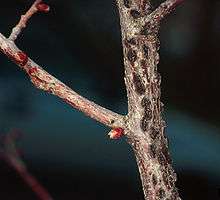Anisogramma anomala
| Anisogramma anomala | |
|---|---|
 | |
| Cankers caused by Anisogramma anomala on a hazlenut branch | |
| Scientific classification | |
| Kingdom: | Fungi |
| Phylum: | Ascomycota |
| Class: | Sordariomycetes |
| Subclass: | Sordariomycetidae |
| Order: | Diaporthales |
| Family: | Gnomoniaceae |
| Genus: | Anisogramma |
| Species: | A. anomala |
| Binomial name | |
| Anisogramma anomala (Peck) E. Müll., (1962) | |
| Synonyms | |
|
Apioporthe anomala (Peck) Höhn., (1917) | |
Anisogramma anomala is a plant pathogen that causes a disease known as Eastern filbert blight on Corylus spp. (hazelnut). Also known as EFB.[1]
Disease Cycle
Anisogramma anomala is an ascomycete that has a two-year disease cycle. Infection is thought to typically occur during the wet season between February and May.[2] The infection typically occurs at the apical bud during periods of high humidity that favor the pathogen. After the initial infection the pathogen can eventually spread to the phloem, cambium, and even the outer xylem. This fungal pathogen produces cankers made up of stromata. The stromata typically develop the second summer after the initial infection. Within the stroma, perithecia are produced that give rise to asci and ascospores. The ascospores are released as a white ooze during wet weather. Wind driven water droplets and splashing spread the spores to new potential hosts.[3]
Hosts & Symptoms
Anisogramma anomala’s host is the European hazelnut. It is a particular problem on Corylus avellana, which is farmed commercially. Wild alternate hosts do exist and make elimination of the disease particularly hard.[4] The predominant infected tissue is the branches. The disease begins producing cankers on the branches that continue to spread each year. The disease is usually diagnosed by the stromata that make up a cankers being identified. The stromata are elliptical and black. They form in rows and continue to grow in this pattern each year because they are perennial.[5] These stromata will eventually emit a white ooze containing spores that can also be used for diagnosis.
Management
There are many different methods for managing Anisogramma anomala. These include both chemical and cultural control of the disease. An integrated management system using both types of control is recommended for Eastern Filbert Blight. Systemic fungicides are recommended when the shoots of the plant are elongating rapidly. If protectant fungicides are going to be used it is recommended to apply every 8 to 17 days.[6] These fungicides interrupt the disease by killing the fungal cells on contact preventing the spread of the disease. Although chemical control can be effective, cultural management is the most common method of control for this disease. Cultural management for Eastern Filbert Blight involves scouting orchards, pruning and removing cankers, and removing plant debris from the ground. Orchards should be scouted thoroughly twice per year to remove cankers. During the winter cankers are easier to observe and should be removed. When removing cankers the branch should be cut 3 feet below the end of the canker. Any material that was removed should be immediately burned or buried. Lastly, susceptible pollinizers should be severely pruned back on a 3 or 4 year rotational schedule.[3] These cultural methods interrupt the spread of the disease through an infected tree. Anisogramma anomala is a slow moving disease and the pruning and removal of infected branches removes the reproductive structures needed to produce spores for infection.
External links
References
- ↑ Chittaranjan Kole (Editor) {{google books|A_YcVIyRRkUC|Wild Crop Relatives: Genomic and Breeding Resources: Forest Trees|page=xvii]]
- ↑ "eastern filbert blight (Anisogramma anomala)". www.plantwise.org. Retrieved 2017-12-15.
- 1 2 "Eastern Filbert Blight - Anisogramma anomala" (PDF). Oregon State University Extension Service.
- ↑ Molnar, Thomas (2010). "Survey of Corylus Resistance to Anisogramma anomala from Different Geographic Locations" (PDF).
- ↑ "Eastern Filbert Blight" (PDF). Cornell University - Plant Disease Diagnostic Clinic.
- ↑ "Anisogramma anomala (eastern filbert blight) - Bugwoodwiki". wiki.bugwood.org. Retrieved 2017-12-15.